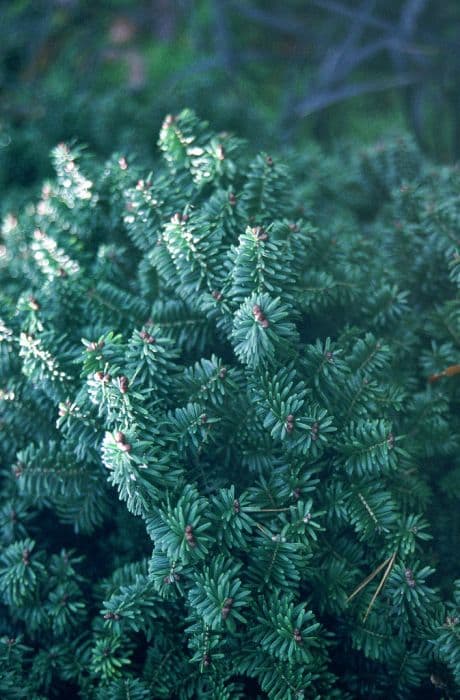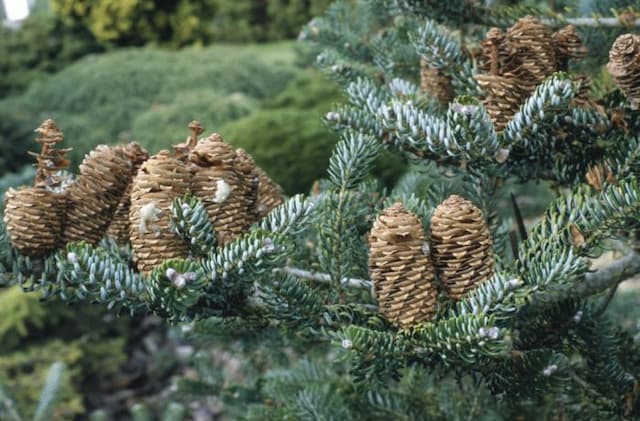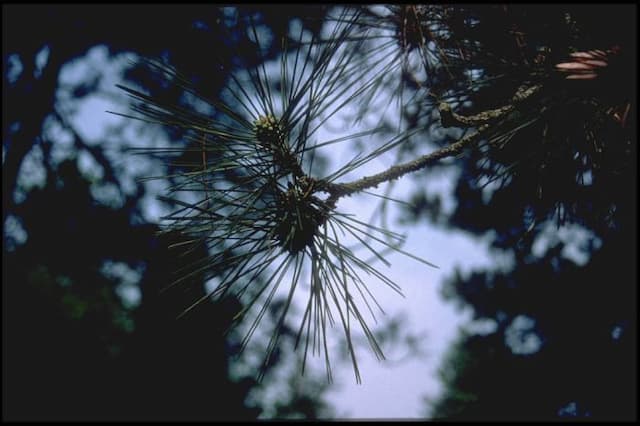Dwarf Serbian Spruce Picea omorika 'Nana'

ABOUT
The plant known as the Dwarf Serbian Spruce is an evergreen conifer with a dense, compact shape that has a rounded, cone-like form. Its needles are short, stiff, and sharp to the touch, displaying a unique two-tone coloration: the top side is a lustrous dark green, while the undersides show off a striking bluish-white, giving the foliage an overall textured and rich appearance. It bears small, brown cones that are not particularly prominent but add to the plant's ornamental value. The branches are horizontal to slightly downward-sloping, creating a neat, tidy look that suits smaller landscapes and gardens well. The Dwarf Serbian Spruce's slow-growing nature and overall appearance make it a favored choice for a focal plant in various garden settings, offering year-round interest with its evergreen foliage.
About this plant
 Names
NamesSynonyms
Serbian Spruce 'Nana', Dwarf Serbian Spruce
Common names
Picea omorika 'Nana'.
 Toxicity
ToxicityTo humans
The Serbian spruce 'Nana', generally isn’t considered poisonous to humans. Typically, there are no severe symptoms associated with ingesting parts of this plant. However, like many other non-edible plants, consuming plant material may cause mild discomfort or irritation of the mouth and stomach, potentially resulting in nausea or vomiting. It’s always best to avoid eating non-food plants due to possible individual allergic reactions or unforeseen toxicities.
To pets
The Serbian spruce 'Nana' is not known to be toxic to pets. Dogs, cats, and other domestic animals can generally come into contact with this plant without the risk of poisoning. Nevertheless, ingestion of any non-food plant material can cause gastrointestinal upset in pets. Symptoms may include vomiting, diarrhea, or abdominal pain. If a pet ingests a significant amount of the plant and shows signs of distress, it is advisable to consult a veterinarian.
 Characteristics
CharacteristicsLife cycle
Perennials
Foliage type
Evergreen
Color of leaves
Green
Height
3-4 feet (91-122 cm)
Spread
2-4 feet (61-122 cm)
Plant type
Tree
Hardiness zones
4
Native area
Southeastern Europe
Benefits
 General Benefits
General Benefits- Compact Size: Suitable for small gardens and spaces due to its slow growth and dwarf form.
- Low Maintenance: Requires minimal pruning and care once established.
- Year-Round Interest: Offers enduring color and texture throughout all seasons with its evergreen needles.
- Drought Tolerant: Once established, it can withstand periods of dry weather, requiring less frequent watering.
- Cold Hardy: Adapted to survive in cold climates, making it an excellent choice for northern gardens.
- Ornamental Appeal: Its unique form and lush green foliage provide visual interest and enhance landscape aesthetics.
- Wildlife Habitat: Provides shelter and nesting sites for birds and other small wildlife.
- Soil Stabilization: Helps prevent soil erosion in sloped or uneven garden areas.
- Adaptable: Can thrive in a variety of soil types as long as they are well-drained.
 Medical Properties
Medical PropertiesThis plant is not used for medical purposes.
 Air-purifying Qualities
Air-purifying QualitiesThis plant is not specifically known for air purifying qualities.
 Other Uses
Other Uses- Serbian Spruce 'Nana' can be used in bonsai culture, being a dwarf variety, it's well-suited for the meticulous pruning and shaping that bonsai requires.
- The dense foliage of Serbian Spruce 'Nana' provides a secure nesting site for birds, offering them protection from predators and harsh weather.
- With its slow growth and compact form, Serbian Spruce 'Nana' is ideal for use in model railroad and architectural scale models as miniature trees.
- The decorative cones of the Serbian Spruce 'Nana' can be collected and used in floral arrangements or as natural Christmas decorations.
- The wood from Serbian Spruce 'Nana', although it's a dwarf variety, may be used in fine woodworking projects for making small, ornamental objects.
- Due to its compact size, the Serbian Spruce 'Nana' can be planted in a large container to decorate patios, terraces, or as a movable landscaping element.
- Serbian Spruce 'Nana' can be planted as a living memorial or dedication tree in small gardens or spaces where a full-size tree would be impractical.
- Branches of the Serbian Spruce 'Nana' can be used for crafting miniature wreaths or for adding a touch of greenery to homemade crafts.
- The neat, symmetrical shape of Serbian Spruce 'Nana' makes it a good candidate for themed gardens, such as fairy or miniature gardens.
- As a winter-hardy plant, Serbian Spruce 'Nana' can be used in cold regions to provide greenery in landscapes where other plants may not thrive.
Interesting Facts
 Feng Shui
Feng ShuiThe Serbian spruce is not used in Feng Shui practice.
 Zodiac Sign Compitability
Zodiac Sign CompitabilityThe Serbian spruce is not used in astrology practice.
 Plant Symbolism
Plant Symbolism- Resilience: Picea omorika 'Nana,' commonly known as Dwarf Serbian Spruce, symbolizes resilience because of its ability to withstand harsh conditions and still maintain its beauty and structure.
- Longevity: Dwarf Serbian Spruce can live for many years, making it a symbol of longevity and endurance through the passage of time.
- Protection: In many cultures, evergreens like the Dwarf Serbian Spruce are believed to ward off evil spirits and are often used in rituals for protection.
- Holiday Spirit: Being an evergreen, Dwarf Serbian Spruce is often associated with the Christmas season and represents the spirit of giving, joy, and celebration.
- Growth and Renewal: The evergreen nature of the Dwarf Serbian Spruce represents continuous growth and the concept of renewal, as it stays green all year round.
 Water
WaterDwarf Serbian Spruce requires consistent moisture, particularly during the first few years after planting and during dry spells. Water this conifer deeply once a week, providing about 1-2 gallons of water per session for a young tree, increasing the amount as the tree matures. Avoid overwatering, as this plant does not tolerate soggy conditions. During hot summer months, it may require more frequent watering, especially if it's not well-established. In winter, reduce watering but ensure the soil doesn't completely dry out.
 Light
LightDwarf Serbian Spruce thrives in full sun to partial shade. It prefers a location where it can receive at least 4-6 hours of direct sunlight daily. However, in regions with very hot summers, some afternoon shade can be beneficial to prevent scorching of the needles.
 Temperature
TemperatureDwarf Serbian Spruce is hardy and adaptable, thriving in USDA Hardiness Zones 4 through 7. It can withstand minimum temperatures down to -30°F and is comfortable in summer temperatures up to 75°F. Ideal temperature conditions for this conifer range between 60°F and 70°F.
 Pruning
PruningPruning of Dwarf Serbian Spruce is generally done to maintain its shape and health. Prune in late winter or early spring before new growth starts. It's a slow growing plant, so pruning is not frequently necessary, but any dead or damaged branches should be removed when observed. Annual thinning is not required unless for shaping purposes.
 Cleaning
CleaningNot needed
 Soil
SoilThe Serbian Spruce 'Nana' thrives best in a soil mix composed of equal parts peat, loam, and sand, which ensures good drainage and aeration. The ideal soil pH for this dwarf conifer is slightly acidic to neutral, ranging from 5.5 to 7.0.
 Repotting
RepottingSerbian Spruce 'Nana' has a slow growth habit and does not need frequent repotting; repot it only every 3 to 4 years to refresh the soil or when the tree has outgrown its current container.
 Humidity & Misting
Humidity & MistingSerbian Spruce 'Nana' prefers moderate to high humidity levels but is tolerant of average household humidity when grown indoors.
 Suitable locations
Suitable locationsIndoor
Provide bright light, cool temps, and well-draining soil.
Outdoor
Plant in well-drained soil, full sun, shelter from harsh winds.
Hardiness zone
4-7 USDA
 Life cycle
Life cycleThe life cycle of the Serbian Spruce 'Nana' (Picea omorika 'Nana') begins with germination, where the seeds sprout after a period of cold stratification, a process mimicking winter conditions. Following seedling emergence, the plant undergoes a juvenile phase, developing into a typical conifer shape with dense, conical growth and producing needle-like foliage. As it matures, the Serbian Spruce 'Nana' enters the vegetative stage, characterized by slow growth due to its dwarf nature, and it may reach a mature height of 3-4 feet over several years. The reproductive phase initiates with the development of cones; male cones release pollen, while female cones, after pollination, develop seeds. Once mature, the Serbian Spruce 'Nana' can produce seeds annually, although seed production can be variable and limited. The plant’s longevity allows it to go through numerous reproductive cycles before it eventually ages and experiences senescence, leading to the end of its life cycle.
 Propogation
PropogationPropogation time
Early Spring
Propogation: Picea omorika 'Nana', also known as Dwarf Serbian Spruce, is typically propagated by softwood cuttings. The ideal time for propagation is late spring to early summer when the new growth is still soft and pliable. To propagate, a cutting of about 4 to 6 inches (10 to 15 cm) is taken from the current year's growth, making sure it includes at least 2 to 3 sets of needles. The lower set of needles is removed, and the base of the cutting is dipped in a rooting hormone to facilitate root development. The cutting is then inserted into a pot filled with a well-draining soil mix and kept moist and under partial shade until roots have developed, which usually takes several weeks. Care must be taken to maintain high humidity around the cuttings during this period, often using a plastic cover or a misting system.









